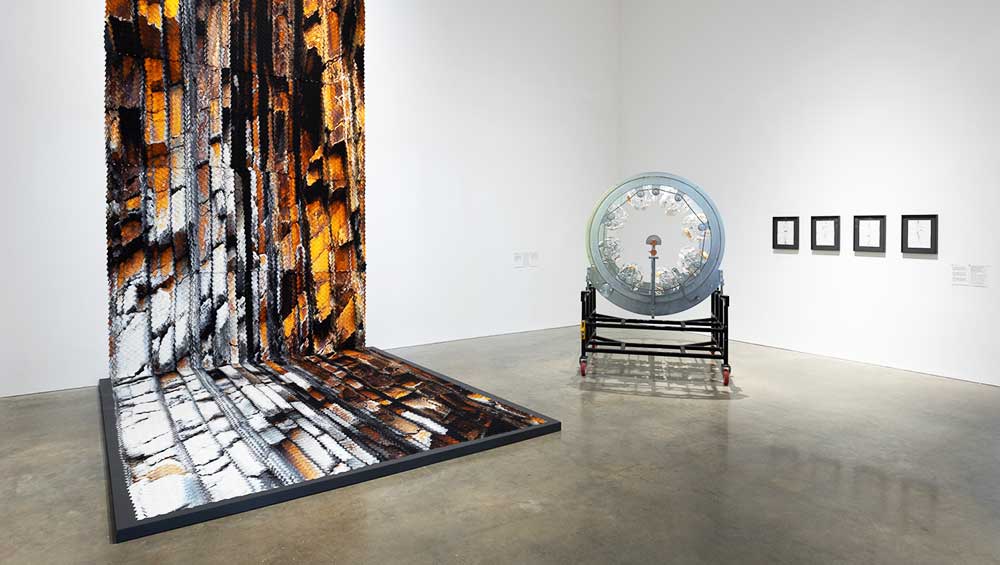
Trickster Figures: Sculpture and the Body, installation view, MK Gallery, 2023. Photo: Rob Harris.
MK Gallery, Milton Keynes
4 February – 7 May 2023
by ANNA McNAY
It has been a long time since I have been to an exhibition that has inspired me as much as this one; one where I sat on the floor in each room and felt compelled to scribble my own thoughts, feelings and responses, before reading the wall texts (which probably overlapped with my own about 50:50). This is an exhibition to which you must respond viscerally, for as much as it is about the body, so it seems somehow to affect the body, as well as the mind, of the viewer. It is a show that can be felt, not just thought – and that, for me, is what art should be all about.
Entering the first room of the six-room group show, curated by Jes Fernie in the fabulously spacious MK Gallery, you would not necessarily guess the subject of the exhibition. Visitors are confronted by Alice Channer’s Soft Sediment Deformation (Iron Bodies) (2023), a wall-hanging comprising 30 panels of industrially pleated fabric, reaching from the ceiling to the ground, where it spills over like a waterfall. At first glance, the mottled, black-orange tyre-track-like pattern could be that of a tiger-skin; look more closely (or perhaps, necessarily, at the label), however, and it is a digitally stretched and distorted image of sandstone from the north Devon coastline, printed on to heavy crepe de chine, and pleated, as if formed from the scales of a fish. As Channer says: “[The surface] has glitches and ruptures and stretches all over it, a lot like my own skin.”
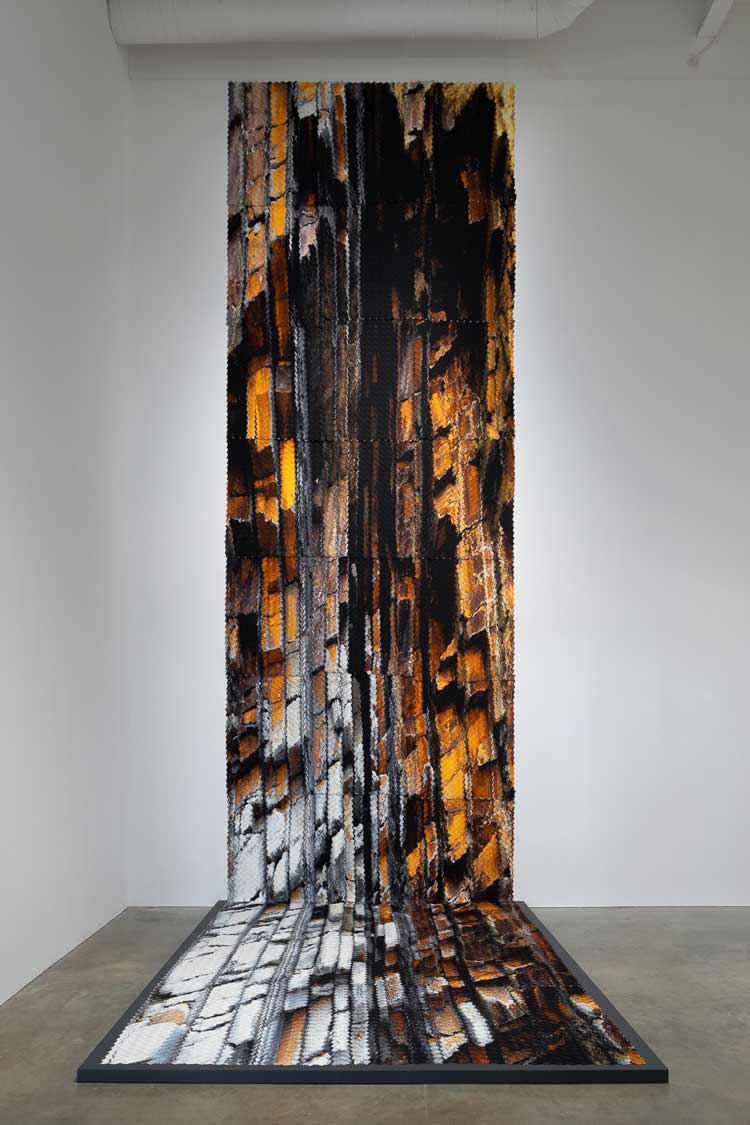
Alice Channer, Soft Sediment Deformation (Iron Bodies), 2023, installation view, Trickster Figures: Sculpture and the Body, MK Gallery, 2023. Photo: Rob Harris.
It is unsettling in its scale and ambiguity, and the camouflage-like skin suggests deceit. And this is how the visitor is introduced to the concept of the “trickster” – according to Merriam Webster, “one who tricks; a dishonest person who defrauds others by trickery; a person (such as a stage magician) skilled in the use of tricks and illusion; a cunning or deceptive character appearing in various forms … The trickster openly questions, disrupts or mocks authority.” The title of the exhibition, then, Trickster Figures, lays open questions concerning bodies that do not conform; bodies seen as somehow “other”; queer bodies; bodies of colour; bodies that, when seen, might make the viewer wish to unsee. And these questions are all elaborated on as the threads that wind from one work to another, through the very different expressions by the 11 artists included, unfurl.
To begin with, there is the question of the body as something that takes up space. This, of course, resonates from Channer’s fabric hanging. With the notion that it might be a hide or a skin of some sort, one wonders what the body would be without this stretchy membrane to hold its shape. Surely it is the skin that renders us incarnate? But what then is the body? The physical, including this exterior, or the intangible spirit it holds? There is no attempt to answer this age-old, philosophical and theological question but, by raising it the minute the visitor walks through the door, the bar is set high for the impact of the works to come.
-5.jpg)
Alice Channer, Planetary System (Kolzer DGK63"), 2019, installation view, Trickster Figures: Sculpture and the Body, MK Gallery, 2023. Photo: Rob Harris.
Other works by Channer in this first room – and the works by each artist are largely grouped together, which by no means diminishes the natural flow of the curation, and there is no abrupt switching or sense that the exhibition comprises multiple solo showcases – include four two-dimensional “drawings” made from pencil, stainless steel microspheres and cigarette ash, depicting “bruised and exhausted lungs”, and Planetary System (Kolzer DGK63”) (2019). For the latter, she has studded a Kolzer DGK63” horizontal system vacuum metallising carousel (a large, cog-like contraption, used to spray household items and car parts with a fine aluminium covering) with crab shells – some metallised, some au naturel – in a comment on the violence that humans inflict on non-human bodies (in this instance, the removal of the crab from its shell, which is then stuffed with crab meat from other crab bodies for human delectation).
This thread, of the human impact on other bodies and our environment, recurs in works by Siobhán Hapaska, whose sculptures refer to a world filled with violent opposing forces and conflicting ideologies, Ro Robertson and Harold Offeh. The ash drawings, on the other hand, consider how our use of certain materials affects, changes and maybe even destroys our own bodies. The trickster here is the foreign body, or material, which Channer describes as a “body with agency” – a wonderful way to conceptualise the myriad materials used not just by the artists in this exhibition but by artists across the globe, certainly those of a more postmodern bent.
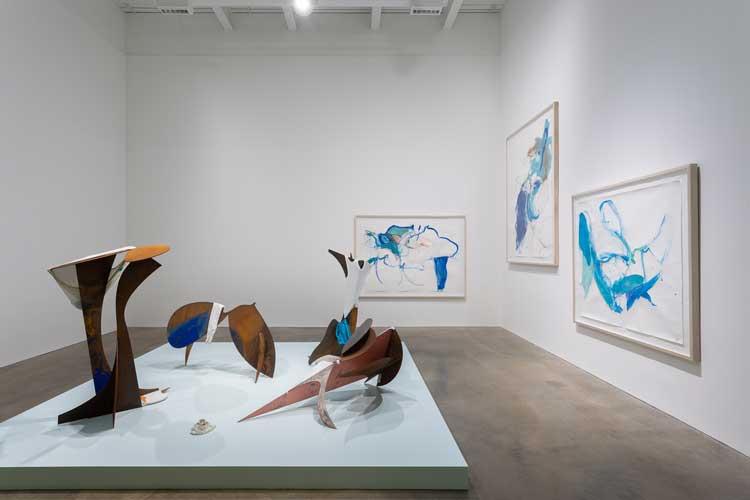
Ro Robertson, installation view, Trickster Figures: Sculpture and the Body, MK Gallery, 2023. Photo: Rob Harris.
Robertson’s “drawings” seem to pick up on and extend this. Hanging, larger than life (here, “life” equates to the visitor’s body) in the next space, they were drawn by the artist “starting on the floor of the studio and free-flow painting lines around the spaces of my body in gouache … This flow is the most vital part of my practice, it allows sculptures to exist and it aims to connect on a level aligned with our inner instincts … This flow is in our bodies and one way or another we must move and not stay still.”1 The sweeping, abstract foot-strokes and swirls, in turquoise, aquamarine, teal and midnight blue, are full of vitality and dynamism, and the paper on which they have been painted has warped as it has dried. Even the paper behind this, forming part of the mount, has buckled, like the wrinkling or sagging of aged skin, beaten by the sun, and no longer able to hold the shape of the body within. Of the three enormous works, the portrait-format one is hung higher than its companions, adding to their imposing and dwarfing nature, making me, once more, acutely aware of my own size and shape; of the space I take up and that which surrounds me.
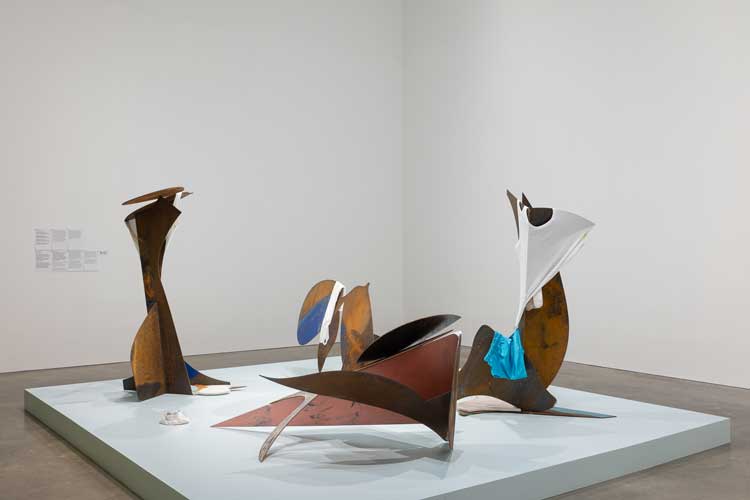
Ro Robertson, Torso I, 2021, Torso II, 2021 and Torso III, 2022, installation view, Trickster Figures: Sculpture and the Body, MK Gallery, 2023. Photo: Rob Harris.
Robertson’s works on paper are coupled with a sculptural installation, which could almost be read as a three-dimensional translation. Corporeal shapes in rusted steel, leaning, anchored, partially “dressed” with turquoise and white found undergarments. Displayed across a low plinth in even paler turquoise, this “body of bodies”, positioned in close proximity to one another so that none stands – or is seen – alone, could be figures at the seaside, exposed and uncomfortably on show. Indeed, Robertson says they make reference to the “masquerade laws” in the US which were used to punish those who challenged gender norms in their choice of clothing.
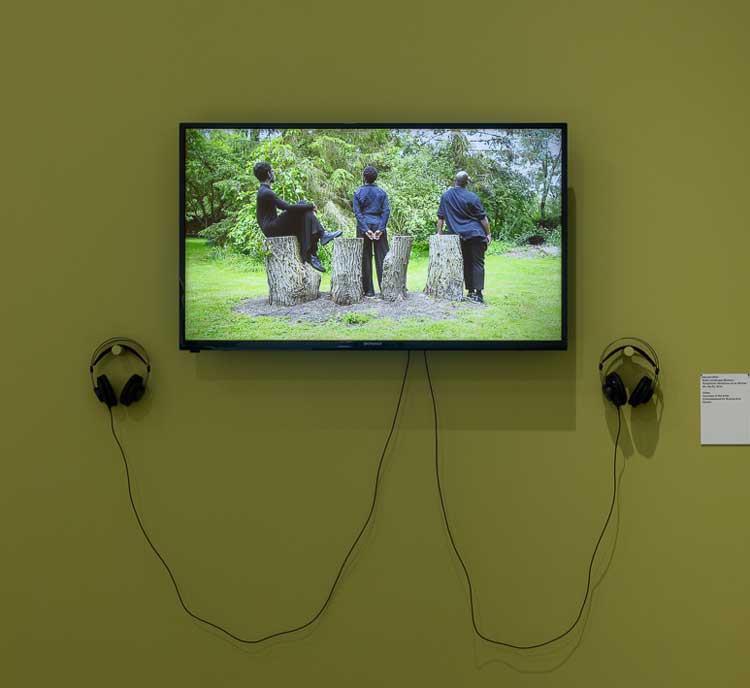
Harold Offeh, titled Body Landscape Memory. Symphonic Variations on an African Air, Op 63, 2019, installation view, Trickster Figures: Sculpture and the Body, MK Gallery, 2023. Photo: Rob Harris.
In the same space, there is a film by Offeh, titled Body Landscape Memory. Symphonic Variations on an African Air, Op 63 (2019). He and two black collaborators pose, like Robertson’s beachgoers, in nature, but as if for a life-drawing class. In one scene, a woman sits on a pile of logs, resonating with Channer’s crabs in the veiled reference to humankind’s effect on its surroundings, our interference with, abuse and destruction of other natural bodies for our own gain. The film is set to a piece of music by the early-20th-century black composer Samuel Coleridge-Taylor, a very “figurative” piece, in which there is a real sense of each instrument having its own living form, interacting and conversing with each another, and with each form’s relative size issuing from the pitch of the notes it sings. The higher, faster violins and pipes, for example, suggest something akin to birds, and the deeper, heavier, slower strains of the bass, the brass and the beating drum evoke the plodding of a bulkier beast such as an elephant.
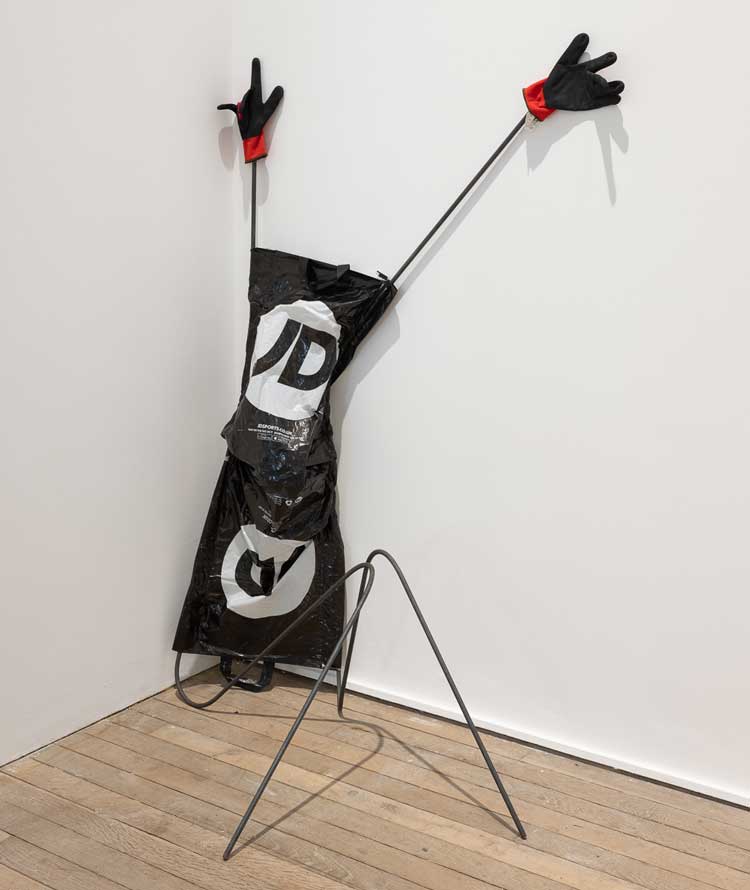
Jesse Darling, It was Present!, 2022, installation view, Trickster Figures: Sculpture and the Body, MK Gallery, 2023. Photo: Rob Harris.
Of a number of sculptures by Jesse Darling, it was Present! (2022) that spoke to me the most. A fragile skeleton of a body (made of steel), collapsed in a corner, wears two plastic bags from JD Sports (chosen for the shared initials with the artist). This labelling could be read as a means of con- and even re-straining the body, which has its arms reaching up, as if in a bid to escape. This buckling of a body is also found in Kira Freije’s Fallen Woman (2016), a curious work, installed at a height on the wall, with a pair of inverted legs inflating (and then deflating) at random intervals. While unnerving my support dog to the point of trembling and hiding behind my legs, this unpredictability and unreliability of the body – which mark a turning point in Freije’s practice, when she wanted to be “surprised” and “move beyond the rigid boundaries of theory and prescribed approaches to making art” – are also common features associated with abjectness.
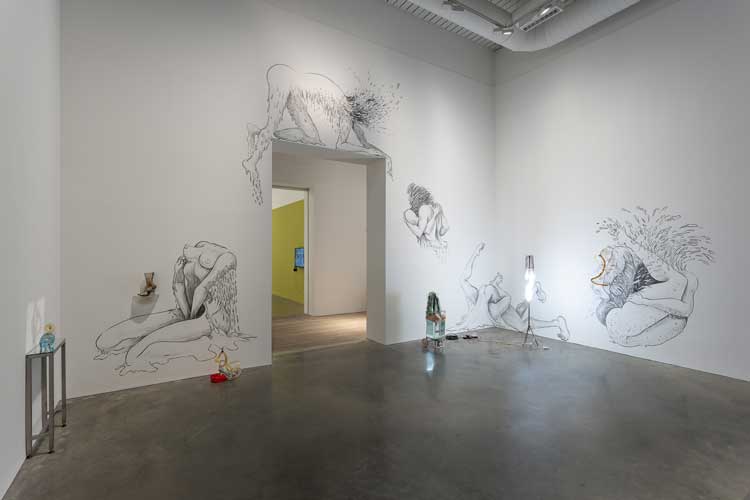
Saelia Aparicio, installation view, Trickster Figures: Sculpture and the Body, MK Gallery, 2023. Photo: Rob Harris.
Abjection, a concept largely defined by Julia Kristeva in her 1982 book Powers of Horror,2 literally means “the state of being cast off”, and has connotations of degradation, baseness and rejection. The abject is that which reminds us of the threat of separation from the other, by transgressing the boundary between the inside and outside of the body, or between the subject and object, disrespecting order, systems and rules. Bodily fluids are extremely abject, and these are at the heart of Saelia Aparicio’s sculptures and wall drawings, together forming the installation Prosthetics for Invertebrates (2019), in the large central gallery. In Our Lady of Cleaning Fluids, tubes filled with foul coloured liquids suggest colostomy and urostomy bags, and in I Cannot Change You So I Must Replace You, a silicon masturbator slides through a glass shoe. The murals depict bodies dissolving, dripping and melting, in the throes of sexual activity (alone and with others), being engulfed by the fluids that come with pleasure. Is the deceit here that pleasure simultaneously causes pain and auto-destruction? Shape-shifting, traditionally thought to be the result of divine intervention, demonic manipulation, sorcery or spells, is shown to be the consequence of the most primal of human activities.
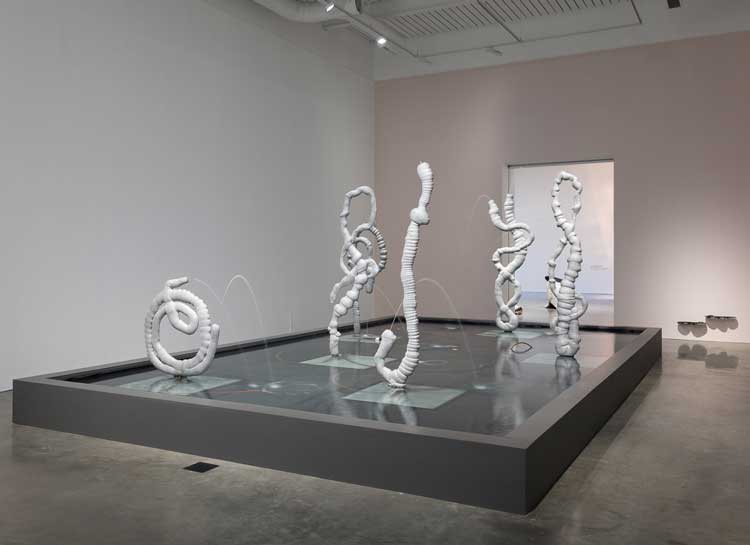
Nicolas Deshayes, installation view, Trickster Figures: Sculpture and the Body, MK Gallery, 2023. Photo: Rob Harris.
Aparicio’s works are set against a large pool by Nicolas Deshayes, in which stand six intestine-like, entangled silver tubes, spouting water like fountains, but with an undercurrent of urination. Some are even leaking from both ends. The sound of this running water can be heard throughout the exhibition, a soundtrack of seepage and leakage, to borrow Fernie’s terms. The “fountains” are flattened on the back, making them as two dimensional as three dimensional gets – again the notion of shape-shifting and of trying, perhaps, to take up less space. Black smudges on the floor of the pool suggest dirty footprints; the traces of a former presence, a body been and gone. Submerged pipes, running between the tubes, are also visible, mirrored by the exposed pipes of the gallery ceiling.
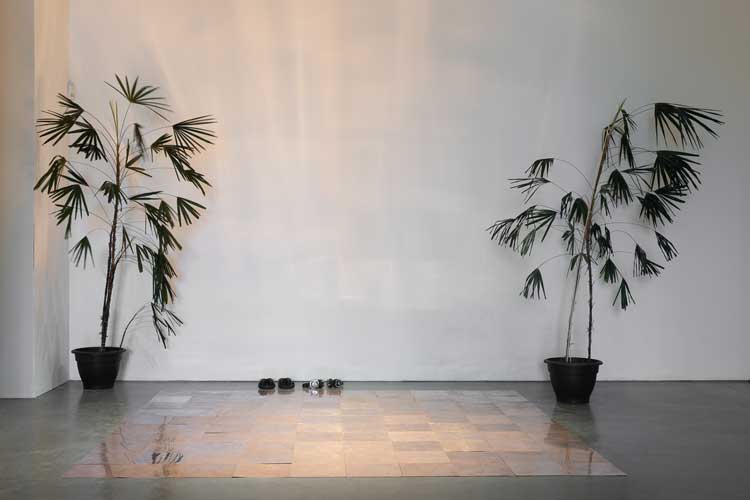
Joe Namy, Disguise as Dancefloor, 2022, installation view, Trickster Figures: Sculpture and the Body, MK Gallery, 2023. Photo: Rob Harris.
Two works – Joe Namy’s Disguise as Dancefloor (2022) and Vanessa da Silva’s Uombee (2023) – invite audience participation, but I’m afraid I passed these by at relative speed. Their impact was felt, nevertheless, as, despite being only too well aware of my inimical relationship with my body, most certainly a trickster of the cruellest ilk, I was shaken by the intensity of my knee-jerk discomfiture at the idea of putting it in the spotlight. I thoroughly enjoyed Nnena Kalu’s fabulously dynamic drawings, hanging several sheets deep at the other end of the room, however, which more than sufficiently embodied the dancing demanded by Namy.

Left: Kira Freije, dipping voices, on the side of the sun, 2022; right: In the way of the wind, 2022, installation view, Trickster Figures: Sculpture and the Body, MK Gallery, 2023. Photo: Rob Harris.
Four final works by Freije conjure up the effect, not of humankind on nature, but, in an interesting reversal, of nature – more specifically the sun – on humankind. In Dipping Voices, On the Side of the Sun (2022), tattered silk, bleached by its rays, hangs over a figure slumped on the ground, as if crawling to seek refuge from the intense heat. Our sun is, of course, the greatest – largest, hottest, and most powerful – body we know, and nevertheless also one that we frequently try to “harness” to our advantage. Is the steel figure of The Forgiver (2022), falling like Icarus from the sky, a warning against our hubris when it comes to our inflated idea of our significance in relation to all other bodies we seek to overpower? Certainly, this sense of our body coming up against, interacting and competing with others, trails the visitor like a shadow – another boundary-transcending, shape-shifting form – throughout the exhibition.
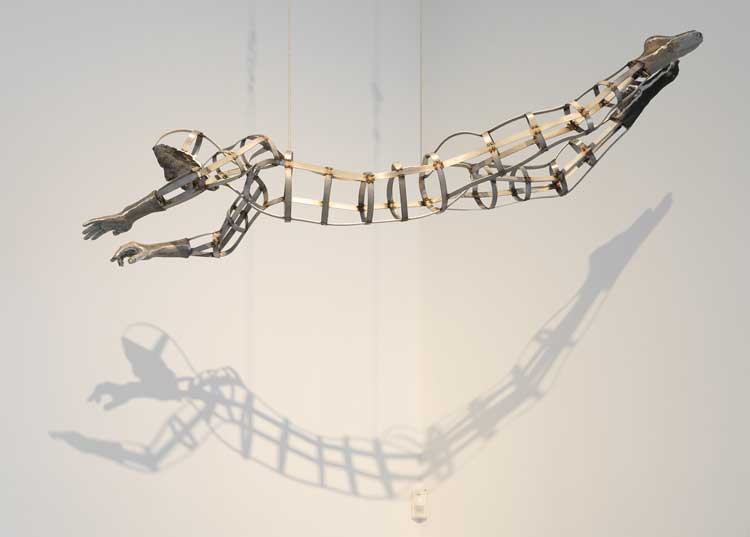
Kira Freije, The Forgiver, 2022, installation view, Trickster Figures: Sculpture and the Body, MK Gallery, 2023. Photo: Rob Harris.
But besides this socio-political take-away, another lesson, again stemming from our arrogance and vanity, might be learned, and it is one that struck me particularly hard. Since this great body, the sun, is a body in constant flux, holding no fixed shape as its component gases move about at immense speed, whatever possesses us to believe we might expect our own bodies to remain constant and passive? Is some level of trickery not par for the course in retaliation against our ceaseless fretting over and fighting against the natural processes of growth, expansion and decline – shape-shifting – as we age? Is it not conceivably less frequently a case of suffering from a trickster figure than it is from a trickster mind? That I am even partially able to entertain this notion is possible only thanks to an exhibition of works that, as I said at the beginning, elicit a range of profound responses in both my body (feelings) and my mind (thoughts). And that is the power of true art. I cannot recommend this exhibition highly enough.
References
1. Excerpt from a comment on the artist’s Instagram page, accompanying a post from 31 October 2022.
2. Powers of Horror: An Essay on Abjection by Julia Kristeva, translated by L S Roudiez, published by Columbia University Press, 1982.